Bees

This is the backyard of my house (April 2012). My original plan was to do chickens under that garage awning, but I changed my mind and decided to do bees, and put the hives just this side of that yellow oregon grape bush. My sister has done both, and she says chickens are simple animals, while bees are much more complex. You can study them for years and still barely understand them. A good internet resource about beekeeping is
Michael Bush's website.
Bees live in an interesting grey area between wild and domesticated. We breed them and take their honey, and some vegans think they're exploited, but unlike other agricultural animals, they know how to survive in the wild and they are free to fly away at any time. In this sense, bees are less exploited than humans!
In popular culture, the bee social order is a metaphor for totalitarianism. But people who observe bees say that they're anarchists: they make decisions collectively, and in colonies of tens of thousands, every worker bee has full participation in power. They even have distinct
personalities.
Types of Hives
The box beehives that you see along the highway, and that are used by all large-scale commercial beekeepers, are called
Langstroth hives. They are designed for human needs: to keep the combs easily removable, to maximize honey production, to enable swapping components from one hive to another, and to be stackable so that bees can be trucked around for pollination. Every box in a Langstroth hive has a bunch of vertical rectangular frames holding "foundation": a sheet of wax or plastic stamped into contoured hexagons from which the bees build out their comb.
After researching the options, I decided not to do Langstroth but Top Bar. A Top Bar hive does not have a stack of boxes, but a single long box, and instead of frames and foundation it just has naked bars from which the bees hang their comb in the air. The big advantage of Top Bar hives is that bees like them better. I read one beekeeper say that Langstroth bees have a high-pitched nervous buzz, while Top Bar bees are lower pitched and mellower. Probably the main reason for this is that Top Bar bees get to engineer their own comb. It's the same reason humans are happier in houses they build themselves than in housing projects. Without foundation, bees can make whatever cell size they want, including making a variety of cell sizes for different functions.
Every time you harvest honey from a Top Bar hive, you harvest the comb too. You squeeze the honey out, then you can put the squished comb in hot water to separate the last of the honey from the wax. Beeswax has many uses, and the honey water can be used for mead. Langstroth beekeepers use an expensive machine called an extractor to remove the honey without damaging the comb, so they can put the used comb back in the hive. The idea is that if bees don't have to waste time building more comb, they can produce more honey, and sometimes this is true. But re-using comb can also re-introduce disease, and bees really like building comb!
Langstroth hives often use a queen excluder and a "honey super", a part of the hive where the queen can't go so the comb is just filled with honey and no eggs or brood. This fits industrial beekeeping because it requires less attention -- you just pull the super off and throw the frames in the extractor. In a Top Bar hive the queen can go everywhere, so you have to look through the frames and find the ones with honey, but typically they're all at one end.
Another way that Top Bar hives require more attention is that the bees don't neatly hang a comb from every bar. Without foundation, they tend to veer off into curving combs between multiple bars or connecting them together, so you have to carefully watch a growing hive and manage the combs to keep the bees on the right track. So Top Bar is good for a backyard hive but not for a remote hive that you leave alone for weeks at time.
Some beekeepers use Langstroth hives without foundation, and there's a popular design of foundationless box hive called a Warre hive. I don't know much about it, but supposedly it's the best hive for enabling the bees to keep a consistent temperature. Top Bar is better for this than Langstroth, because the bars themselves form the roof of the hive, and you only open it one bar at a time, instead of opening the lid and exposing cracks between all the frames at once.
Another advantage of Top Bar is that you never have to lift a heavy box, only individual bars. And one more advantage is they're the easiest hive to build yourself. One thing I did not do myself was make the bars, because I had only a few pieces of scrap wood in the right dimensions. Instead I spent $100 to order 60 really good
top bars from Bee Thinking, precisely cut with wedge shaped guides for the bees to start their comb. People who make their own bars often cut a groove and glue in popsicle sticks.
My Hives
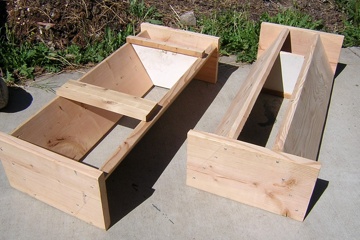
Here are the basic frames for two Top Bar hives. The one on the left is right side up, and these are called Kenyan hives because of the sloping sides. Tanzanian Top Bar hives have vertical sides, which is a bit easier to build, but the advantage of the slope is that the comb has to be smaller as it gets farther down, so as the comb gets larger and heavier, it also has a proportionally larger connection to the bar, and it's less likely to fall off.
Following the advice in
this video by David Wright, I attached the sides to the ends by first making follower boards and using them as a template. The follower boards are those two flat white things, and in a completed hive you use them to change the internal size, so a small colony can stay cozy and later have room to expand. I cut the boards to precise dimensions (16 inches on top, 5 on the bottom, 11 on the edges, 120 degree angles), screwed them onto top bars, and arranged the wood like the hive on the right, with both follower boards in there and the side boards leaned up against them, and a big T-square on the floor to get it square, before putting in the screws. I used 3 1/2 inch square/phillips drive Spax screws and drilled pilot holes.
In the frame on the left, notice that the end boards are higher than the sides, to match the thickness of the bars. I stuck three bars in the middle so you can see how they fit. And in the upside down frame on the right, notice that I let the corners of the side boards stick out and then sanded them down, to make a wider fitting surface for the bottom boards.
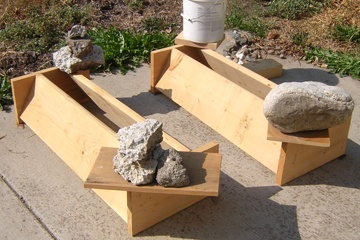
Now there was a complication. Notice that I'm using 2 inch (really 1 1/2 inch) lumber. All the plans I saw online said to use 1 inch (really 3/4 inch) boards. But when I went to Home Depot to buy them, the thicker boards were two thirds the price of the thinner boards, and twice as thick, which equals three times the value! So I got the thick boards (2x12 douglas fir) and because the wood was not completely dried before being milled, when they finished drying, they spiraled. This is a typical problem with cheap lumber. So the hives themselves became spiraled, and the bottom boards and lids would be wobbly unless I straightened out the main body. In this photo you see how I did it by putting heavy weights on opposite corners, and bits of wood under the other opposite corners, for a week or two. That bucket is full of water and rocks.
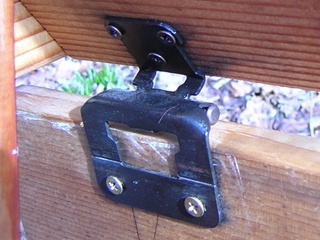
Next were the bottom boards. For these I used 3/4 inch boards from a cabinet I tore out in another project. Some people nail them on permanently, some people design them to slide in and out, and I decided to put them on hinges and latches so I could easily open and close them. There is controversy about whether open bottoms help the bees keep cool in summer, but they definitely help by forcing mites that fall off the bees to fall out of the hive, instead of climbing back up. You also need a screen to keep the bees in, which I'll get to later. This photo is a closeup of one of the hinges, which were tricky.

I couldn't find any hinges that fit the way I wanted, so I did a hack. These are two hinges I bought from Lowes, the one on the left unaltered, and the one the right with a 90 degree angle flattened out using Knipex parallel pliers. For latches I used Stanley chest latches, and strangely none of the big box stores in Spokane carry them, so ended up ordering some off eBay.

Next I put the legs on. I cut scrap 2x4's 30 inches long with a 45 degree angle on top and an angle on the bottom to fit the ground, and attached them with carriage bolts. Bolts are more expensive than screws, but it's much easier if I ever need to replace a leg with bees inside. God help you if you used nails!

Next, I decided to make both hives with observation windows. At Lowes for less than $10 I was able to buy a piece of glass and have them cut two pieces 30 inches by 5 inches. Then I cut a smaller rectangle all the way through one side of each hive, using a drill to get it started, then a keyhole saw and a regular saw. All sawing on this project was done with Japanese hand saws from Hardwick's in Seattle. Then with a chisel I made a quarter inch deep notch around the edge to fit the glass into. I wanted the glass flush with the inside so if the follower board is against the glass, the bees can't get around it. It's held in by gravity, and I also used a bunch of bathroom caulk (you can see this in another photo below). I expect bees to finish the job with propolis, which is bee glue made from plant resin.

Here you see a completed window with door. The window has to be covered because bees like the dark. I used scrap wood and scrap hinges and did the same thing as the bottom board hinges to bend them and make them fit. It was really tricky to get that cupboard door closer thingy lined up right. (Hint: the last step was screwing the hinges to the hive.) The foam is for insulation and it's stuck on with non-toxic wood glue. Notice that the window is more toward the entrance side, because if they ever use the full hive, the bars farthest from the entrance will be for honey storage without a lot of bee action.
Next is the lid, and now I have to mention the entrance. Bees need a large entrance, or many small ones, when they're foraging in the summer, and in the winter, just enough of an opening to blow moisture out of the hive. Normally a Top Bar hive has holes drilled in one of the ends or in the end of one of the sides, and the size of the hole is often designed to be plugged with a wine cork so the beekeeper can add or remove corks to change the number of openings.
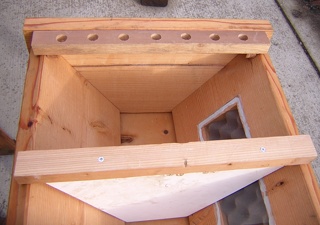
I wanted a top entrance, because I eventually want to harvest pollen, and the best pollen trap, the Sundance 2, is designed to fit on the
top of a Langstroth hive. A pollen trap is stressful enough for the bees, and I don't want to stress them more by making them switch from a side to a top entrance, so I decided to give them a top entrance from the very beginning. My first idea was to leave a permanent gap between the hive and the first bar... but how could I regulate the size and get it small enough in winter? My next idea was what you see in this photo, to make the first bar an entrance bar with holes drilled through the top. Notice the tiny pieces of wood I nailed to the bottom of the bar to keep it in place, and in this photo you can also get a better look at a follower board and the window caulking. I was thinking I could open or close holes with corks, but then I thought of this...
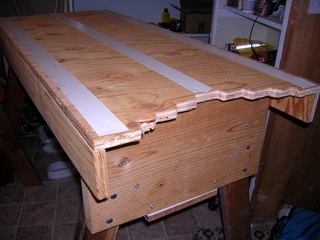
As far as I know, no one has ever tried this. The lid itself is cut so that by sliding it, I can open or cover holes. It's designed for 1, 3, 5, or 7, but if I did it again, I would do 1, 2, 4, and 8, so that each increase would be double. Other than that the lid foundation is simple: top, sides, no ends, cut from heavy 3/4 inch plywood and screwed together. The length of the hive is 47 inches, and plywood is 48 inches wide, so I could use it efficiently with minimum sawing and still get a bit of overhang. That tape is for the next stage.
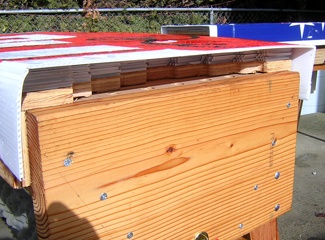
Here you see the final lid, and how the bees get to the holes without rain getting in. The corrugated plastic is from 4x8 campaign signs, which I snagged in my truck right after the election. It's waterproof, almost weightless, a great insulator, and useful for many things. If you have to buy it it's ridiculously expensive. I picked the prettiest parts of the prettiest signs for the tops of the lids, but unfortunately, Spokane is too conservative to have yellow or green signs, so I'll have the red hive and the blue hive. Possibly the bright colors will help the bees. I looked online for recommendations on the best glue to hold it all together, and someone suggested carpet tape, which was perfect. The sides were attached with a staple hammer, and I sealed a few small holes with some Vulkem 116 that was left over from the rain gutter project.
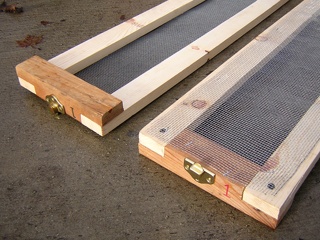
Finally, the screens. To keep bees in and let mites fall through, you need eighth inch hardware cloth, and nobody in Spokane sells it, so I had to go to McLendon Hardware in Seattle. My first idea was to permanently staple the screen to the inside of the hive, just above the bottom board. But I saw three problems. First, stuff will inevitably fall on the bottom of the hive, like tools and pieces of comb, and it will be hard to get it out without disturbing the bees. Second, if I feed the bees by pouring sugar on the bottom board, they won't be able to get to all of it through the screen. Third, if the bees want to stick propolis in the cracks to seal up tightly for winter, they won't be able to get through the screen to the cracks on the edge of the bottom board. So I decided to go with removable screens on frames. Here you can see how I made them. Each piece of dark wood is a 2x4 cut in half lengthwise.
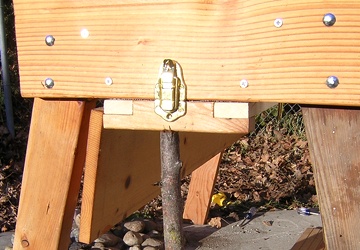
And here's how I attached them. That stick is propped on a rock that you can't see, I used a board and a rock on the other end, and the goal was to push the screen rack hard against the hive to position it for screwing in the latches. In the picture above you can see numbers I wrote on them later, because they only fit a certain way. Another trick was that I noticed the long side pieces of wood were slightly bowed, and I made it so the bows pressed up against the bottom of the hive, so there aren't cracks for bees to get out or enemy bees to get in.

Finally, here they are all finished, in roughly their final position. I'll probably put them a little farther apart, and I may angle them. Here the entrances are facing east for morning light, but southeast might be better for heat. I've also coated all the outside wood with flax oil, except I ran out before I got to the window doors. "Boiled linseed oil" is not actually boiled but has toxic solvents added, so I use expired food grade flax oil if I can find it.
I still don't know where I'm going to get bees. The best deal through mail order seems to be $125 after shipping from Draper's in Pennsylvania, but those are Italian bees. The Carniolan variety would work better for me, and I can pick those up for $100 after tax if I drive six hours to Quilcene Washington. But a local feral colony would be best of all, and I may take my chances and try to catch a swarm with one or two bait hives.

 This is the backyard of my house (April 2012). My original plan was to do chickens under that garage awning, but I changed my mind and decided to do bees, and put the hives just this side of that yellow oregon grape bush. My sister has done both, and she says chickens are simple animals, while bees are much more complex. You can study them for years and still barely understand them. A good internet resource about beekeeping is Michael Bush's website.
This is the backyard of my house (April 2012). My original plan was to do chickens under that garage awning, but I changed my mind and decided to do bees, and put the hives just this side of that yellow oregon grape bush. My sister has done both, and she says chickens are simple animals, while bees are much more complex. You can study them for years and still barely understand them. A good internet resource about beekeeping is Michael Bush's website. Here are the basic frames for two Top Bar hives. The one on the left is right side up, and these are called Kenyan hives because of the sloping sides. Tanzanian Top Bar hives have vertical sides, which is a bit easier to build, but the advantage of the slope is that the comb has to be smaller as it gets farther down, so as the comb gets larger and heavier, it also has a proportionally larger connection to the bar, and it's less likely to fall off.
Here are the basic frames for two Top Bar hives. The one on the left is right side up, and these are called Kenyan hives because of the sloping sides. Tanzanian Top Bar hives have vertical sides, which is a bit easier to build, but the advantage of the slope is that the comb has to be smaller as it gets farther down, so as the comb gets larger and heavier, it also has a proportionally larger connection to the bar, and it's less likely to fall off. Now there was a complication. Notice that I'm using 2 inch (really 1 1/2 inch) lumber. All the plans I saw online said to use 1 inch (really 3/4 inch) boards. But when I went to Home Depot to buy them, the thicker boards were two thirds the price of the thinner boards, and twice as thick, which equals three times the value! So I got the thick boards (2x12 douglas fir) and because the wood was not completely dried before being milled, when they finished drying, they spiraled. This is a typical problem with cheap lumber. So the hives themselves became spiraled, and the bottom boards and lids would be wobbly unless I straightened out the main body. In this photo you see how I did it by putting heavy weights on opposite corners, and bits of wood under the other opposite corners, for a week or two. That bucket is full of water and rocks.
Now there was a complication. Notice that I'm using 2 inch (really 1 1/2 inch) lumber. All the plans I saw online said to use 1 inch (really 3/4 inch) boards. But when I went to Home Depot to buy them, the thicker boards were two thirds the price of the thinner boards, and twice as thick, which equals three times the value! So I got the thick boards (2x12 douglas fir) and because the wood was not completely dried before being milled, when they finished drying, they spiraled. This is a typical problem with cheap lumber. So the hives themselves became spiraled, and the bottom boards and lids would be wobbly unless I straightened out the main body. In this photo you see how I did it by putting heavy weights on opposite corners, and bits of wood under the other opposite corners, for a week or two. That bucket is full of water and rocks. Next were the bottom boards. For these I used 3/4 inch boards from a cabinet I tore out in another project. Some people nail them on permanently, some people design them to slide in and out, and I decided to put them on hinges and latches so I could easily open and close them. There is controversy about whether open bottoms help the bees keep cool in summer, but they definitely help by forcing mites that fall off the bees to fall out of the hive, instead of climbing back up. You also need a screen to keep the bees in, which I'll get to later. This photo is a closeup of one of the hinges, which were tricky.
Next were the bottom boards. For these I used 3/4 inch boards from a cabinet I tore out in another project. Some people nail them on permanently, some people design them to slide in and out, and I decided to put them on hinges and latches so I could easily open and close them. There is controversy about whether open bottoms help the bees keep cool in summer, but they definitely help by forcing mites that fall off the bees to fall out of the hive, instead of climbing back up. You also need a screen to keep the bees in, which I'll get to later. This photo is a closeup of one of the hinges, which were tricky. I couldn't find any hinges that fit the way I wanted, so I did a hack. These are two hinges I bought from Lowes, the one on the left unaltered, and the one the right with a 90 degree angle flattened out using Knipex parallel pliers. For latches I used Stanley chest latches, and strangely none of the big box stores in Spokane carry them, so ended up ordering some off eBay.
I couldn't find any hinges that fit the way I wanted, so I did a hack. These are two hinges I bought from Lowes, the one on the left unaltered, and the one the right with a 90 degree angle flattened out using Knipex parallel pliers. For latches I used Stanley chest latches, and strangely none of the big box stores in Spokane carry them, so ended up ordering some off eBay. Next I put the legs on. I cut scrap 2x4's 30 inches long with a 45 degree angle on top and an angle on the bottom to fit the ground, and attached them with carriage bolts. Bolts are more expensive than screws, but it's much easier if I ever need to replace a leg with bees inside. God help you if you used nails!
Next I put the legs on. I cut scrap 2x4's 30 inches long with a 45 degree angle on top and an angle on the bottom to fit the ground, and attached them with carriage bolts. Bolts are more expensive than screws, but it's much easier if I ever need to replace a leg with bees inside. God help you if you used nails! Next, I decided to make both hives with observation windows. At Lowes for less than $10 I was able to buy a piece of glass and have them cut two pieces 30 inches by 5 inches. Then I cut a smaller rectangle all the way through one side of each hive, using a drill to get it started, then a keyhole saw and a regular saw. All sawing on this project was done with Japanese hand saws from Hardwick's in Seattle. Then with a chisel I made a quarter inch deep notch around the edge to fit the glass into. I wanted the glass flush with the inside so if the follower board is against the glass, the bees can't get around it. It's held in by gravity, and I also used a bunch of bathroom caulk (you can see this in another photo below). I expect bees to finish the job with propolis, which is bee glue made from plant resin.
Next, I decided to make both hives with observation windows. At Lowes for less than $10 I was able to buy a piece of glass and have them cut two pieces 30 inches by 5 inches. Then I cut a smaller rectangle all the way through one side of each hive, using a drill to get it started, then a keyhole saw and a regular saw. All sawing on this project was done with Japanese hand saws from Hardwick's in Seattle. Then with a chisel I made a quarter inch deep notch around the edge to fit the glass into. I wanted the glass flush with the inside so if the follower board is against the glass, the bees can't get around it. It's held in by gravity, and I also used a bunch of bathroom caulk (you can see this in another photo below). I expect bees to finish the job with propolis, which is bee glue made from plant resin. Here you see a completed window with door. The window has to be covered because bees like the dark. I used scrap wood and scrap hinges and did the same thing as the bottom board hinges to bend them and make them fit. It was really tricky to get that cupboard door closer thingy lined up right. (Hint: the last step was screwing the hinges to the hive.) The foam is for insulation and it's stuck on with non-toxic wood glue. Notice that the window is more toward the entrance side, because if they ever use the full hive, the bars farthest from the entrance will be for honey storage without a lot of bee action.
Here you see a completed window with door. The window has to be covered because bees like the dark. I used scrap wood and scrap hinges and did the same thing as the bottom board hinges to bend them and make them fit. It was really tricky to get that cupboard door closer thingy lined up right. (Hint: the last step was screwing the hinges to the hive.) The foam is for insulation and it's stuck on with non-toxic wood glue. Notice that the window is more toward the entrance side, because if they ever use the full hive, the bars farthest from the entrance will be for honey storage without a lot of bee action. I wanted a top entrance, because I eventually want to harvest pollen, and the best pollen trap, the Sundance 2, is designed to fit on the top of a Langstroth hive. A pollen trap is stressful enough for the bees, and I don't want to stress them more by making them switch from a side to a top entrance, so I decided to give them a top entrance from the very beginning. My first idea was to leave a permanent gap between the hive and the first bar... but how could I regulate the size and get it small enough in winter? My next idea was what you see in this photo, to make the first bar an entrance bar with holes drilled through the top. Notice the tiny pieces of wood I nailed to the bottom of the bar to keep it in place, and in this photo you can also get a better look at a follower board and the window caulking. I was thinking I could open or close holes with corks, but then I thought of this...
I wanted a top entrance, because I eventually want to harvest pollen, and the best pollen trap, the Sundance 2, is designed to fit on the top of a Langstroth hive. A pollen trap is stressful enough for the bees, and I don't want to stress them more by making them switch from a side to a top entrance, so I decided to give them a top entrance from the very beginning. My first idea was to leave a permanent gap between the hive and the first bar... but how could I regulate the size and get it small enough in winter? My next idea was what you see in this photo, to make the first bar an entrance bar with holes drilled through the top. Notice the tiny pieces of wood I nailed to the bottom of the bar to keep it in place, and in this photo you can also get a better look at a follower board and the window caulking. I was thinking I could open or close holes with corks, but then I thought of this... As far as I know, no one has ever tried this. The lid itself is cut so that by sliding it, I can open or cover holes. It's designed for 1, 3, 5, or 7, but if I did it again, I would do 1, 2, 4, and 8, so that each increase would be double. Other than that the lid foundation is simple: top, sides, no ends, cut from heavy 3/4 inch plywood and screwed together. The length of the hive is 47 inches, and plywood is 48 inches wide, so I could use it efficiently with minimum sawing and still get a bit of overhang. That tape is for the next stage.
As far as I know, no one has ever tried this. The lid itself is cut so that by sliding it, I can open or cover holes. It's designed for 1, 3, 5, or 7, but if I did it again, I would do 1, 2, 4, and 8, so that each increase would be double. Other than that the lid foundation is simple: top, sides, no ends, cut from heavy 3/4 inch plywood and screwed together. The length of the hive is 47 inches, and plywood is 48 inches wide, so I could use it efficiently with minimum sawing and still get a bit of overhang. That tape is for the next stage. Here you see the final lid, and how the bees get to the holes without rain getting in. The corrugated plastic is from 4x8 campaign signs, which I snagged in my truck right after the election. It's waterproof, almost weightless, a great insulator, and useful for many things. If you have to buy it it's ridiculously expensive. I picked the prettiest parts of the prettiest signs for the tops of the lids, but unfortunately, Spokane is too conservative to have yellow or green signs, so I'll have the red hive and the blue hive. Possibly the bright colors will help the bees. I looked online for recommendations on the best glue to hold it all together, and someone suggested carpet tape, which was perfect. The sides were attached with a staple hammer, and I sealed a few small holes with some Vulkem 116 that was left over from the rain gutter project.
Here you see the final lid, and how the bees get to the holes without rain getting in. The corrugated plastic is from 4x8 campaign signs, which I snagged in my truck right after the election. It's waterproof, almost weightless, a great insulator, and useful for many things. If you have to buy it it's ridiculously expensive. I picked the prettiest parts of the prettiest signs for the tops of the lids, but unfortunately, Spokane is too conservative to have yellow or green signs, so I'll have the red hive and the blue hive. Possibly the bright colors will help the bees. I looked online for recommendations on the best glue to hold it all together, and someone suggested carpet tape, which was perfect. The sides were attached with a staple hammer, and I sealed a few small holes with some Vulkem 116 that was left over from the rain gutter project. Finally, the screens. To keep bees in and let mites fall through, you need eighth inch hardware cloth, and nobody in Spokane sells it, so I had to go to McLendon Hardware in Seattle. My first idea was to permanently staple the screen to the inside of the hive, just above the bottom board. But I saw three problems. First, stuff will inevitably fall on the bottom of the hive, like tools and pieces of comb, and it will be hard to get it out without disturbing the bees. Second, if I feed the bees by pouring sugar on the bottom board, they won't be able to get to all of it through the screen. Third, if the bees want to stick propolis in the cracks to seal up tightly for winter, they won't be able to get through the screen to the cracks on the edge of the bottom board. So I decided to go with removable screens on frames. Here you can see how I made them. Each piece of dark wood is a 2x4 cut in half lengthwise.
Finally, the screens. To keep bees in and let mites fall through, you need eighth inch hardware cloth, and nobody in Spokane sells it, so I had to go to McLendon Hardware in Seattle. My first idea was to permanently staple the screen to the inside of the hive, just above the bottom board. But I saw three problems. First, stuff will inevitably fall on the bottom of the hive, like tools and pieces of comb, and it will be hard to get it out without disturbing the bees. Second, if I feed the bees by pouring sugar on the bottom board, they won't be able to get to all of it through the screen. Third, if the bees want to stick propolis in the cracks to seal up tightly for winter, they won't be able to get through the screen to the cracks on the edge of the bottom board. So I decided to go with removable screens on frames. Here you can see how I made them. Each piece of dark wood is a 2x4 cut in half lengthwise. And here's how I attached them. That stick is propped on a rock that you can't see, I used a board and a rock on the other end, and the goal was to push the screen rack hard against the hive to position it for screwing in the latches. In the picture above you can see numbers I wrote on them later, because they only fit a certain way. Another trick was that I noticed the long side pieces of wood were slightly bowed, and I made it so the bows pressed up against the bottom of the hive, so there aren't cracks for bees to get out or enemy bees to get in.
And here's how I attached them. That stick is propped on a rock that you can't see, I used a board and a rock on the other end, and the goal was to push the screen rack hard against the hive to position it for screwing in the latches. In the picture above you can see numbers I wrote on them later, because they only fit a certain way. Another trick was that I noticed the long side pieces of wood were slightly bowed, and I made it so the bows pressed up against the bottom of the hive, so there aren't cracks for bees to get out or enemy bees to get in. Finally, here they are all finished, in roughly their final position. I'll probably put them a little farther apart, and I may angle them. Here the entrances are facing east for morning light, but southeast might be better for heat. I've also coated all the outside wood with flax oil, except I ran out before I got to the window doors. "Boiled linseed oil" is not actually boiled but has toxic solvents added, so I use expired food grade flax oil if I can find it.
Finally, here they are all finished, in roughly their final position. I'll probably put them a little farther apart, and I may angle them. Here the entrances are facing east for morning light, but southeast might be better for heat. I've also coated all the outside wood with flax oil, except I ran out before I got to the window doors. "Boiled linseed oil" is not actually boiled but has toxic solvents added, so I use expired food grade flax oil if I can find it.